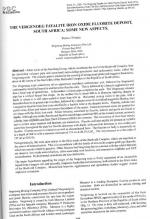Добрый день, Коллеги. Важное сообщение, просьба принять участие. Музей Ферсмана ищет помощь для реставрационных работ в помещении. Подробности по ссылке
The Vergenoeg fayalite iron oxide fluorite deposit, South Africa: some new aspects
Felsic rocks of the Rooiberg Group, which constitutes the roof of the Bushveld Complex., host the discordant volcanic pipe and associated surrounding pyroclastic and sedimentary rocks, called the Vergenoeg suite. The volcanic pipe is situated at the crossing of strong aerial photo and magnetic lineaments, about in the centre of the four lobes of the Bushveld Complex in the Republic of South Africa.
The Vergenoeg suite constitutes of an uppermost stratiform sedimentary unit, followed by fragmental conformably stratified hematite and hematite-fluorite units. This is followed by a breccia agglomerate and then a basal unit of ignimbrites. A discordant volcanic pipe completes the suite. The Vergenoeg volcanic pipe has a vertical funnel-like shape. At the surface this is about 900 m in diameter, tapering sharply in depth to where it is still open-ended at more than 650 m. Horizontal zoning exists in the pipe, with a hematite-fluorite or gossan cap at surface, followed by a deeper zone of unoxidised magnetite-fluorite, then a magnetite-fayalite transition zone and finally a fayalite zone at the deepest levels. Fluorite, siderite and pyrite veins, dykes and lenses are present throughout all the zones. Contacts between zones are gradual but are sharp with the felsic host rock. Felsite breccias, cemented by fluorite, siderite and pyrite are found at depths. Although iron oxide, fluorite and fayalite assemblages constitute 90% of the mineral content, accessory siderite, iron-sulphides and Rare Earth Elements (REE) are common. The occurrence of most base metals, and in certain areas uranium and thorium, are anomalous. Fluorite and iron oxides are present in variable quantities throughout the pipe but fluorite decreases with depth, with resultant increases in iron oxides and fayalite. Fluorite occurs in a massive as well as disseminated form. The fluorite ore body is essentially up to a depth of 360 m with a resource estimate of 174 mt at 28.1% CaFr The iron resource is in the order of 195mtat42%Fe.
Petrogenetically, this rock suite relates to the felsic rocks of the Bushveld Complex, which are regarded as the source of mineralisation. This is in accordance with the family of iron oxide copper-gold type deposits, which are mostly related to granites. Other features that Vergenoeg has in common with the related deposits are massive iron oxide mineralisation, often associated with breccias, and anomalous sulphides and REE mineralisation. Hydrothermal alterations are also distinctive.
The major hypotheses regarding the origin of the Vergenoeg suite is firstly separation of an immiscible liquid from a magma cell, and secondly, magmatic hydrothermal alterations, both related to the felsic rocks of the Bushveld Complex. Mineralised breccias, agglomerates and ignimbrites further suggest violent explosive volcanism.




